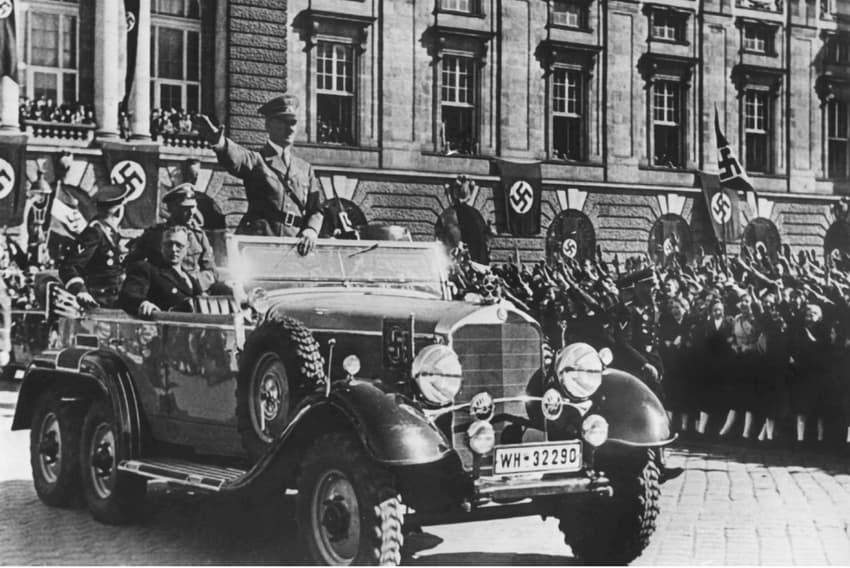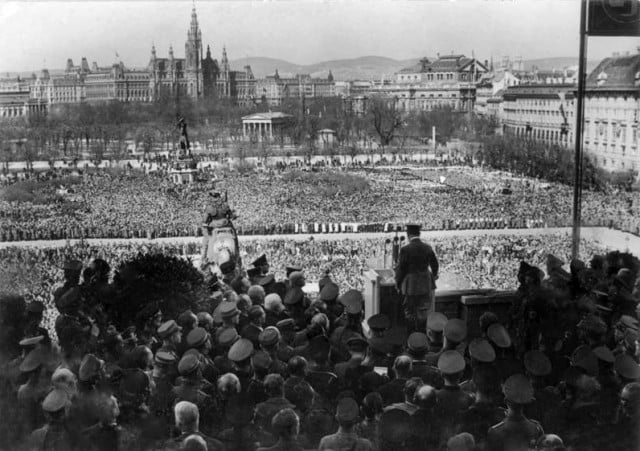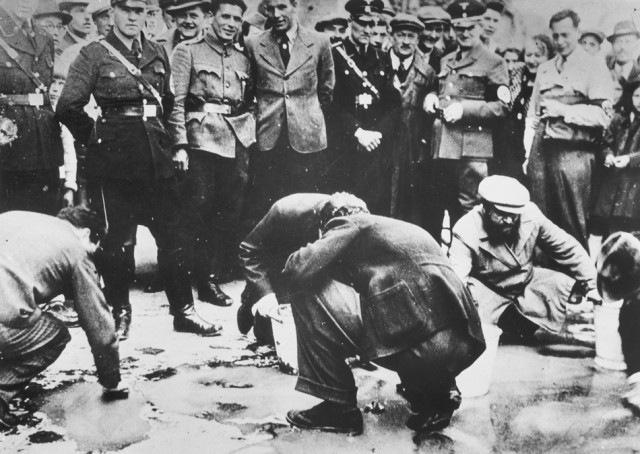‘Hitler didn’t intend to annex Austria so quickly, then the joyful crowds changed his mind’

It is almost exactly 80 years since Hitler’s Wehrmacht marched into Austria. But while the dictator was after Austrian gold, he didn’t immediately intend to annex the country of his birth, a historian in Vienna claims.
This article is available to Members of The Local. Read more Membership Exclusives here.
Austria’s last breath lasted less than 12 hours. On March 11th 1938, at 7.47pm Chancellor Kurt Schuschnigg told his country that he was stepping down, finishing his speech with the words “God protect Austria.”
At dawn the next day five German divisions marched across the border without meeting resistance. Despite lacking petrol, the invasion rolled along largely as planned. At 4pm Adolf Hitler's convoy entered Austria. His first stop was his hometown Linz, which lies 80km southeast of the German border.
At 8pm, he spoke in front of a jubilant crowd of townsfolk. It was only upon witnessing this almost hysterical reception, that Hitler spontaneously decided to wipe Austria from the map, Oliver Rathkolb, a historian at the University of Vienna says.
“At first the plan was to install Hitler as head of government for two countries. But then the jubilation of the crowds created a new dynamic, so that they said 'we will drop the provisional solution',” Rathkolb explains.
Hitler didn’t hesitate for long. On March 13th, he issued a decree of union, stating that “Austria is a part of the German Reich.”
The “Anschluss” between the two countries was to be total - it even meant that Austrians had to switch from driving on the left to driving on the right like the Germans.
Two days later Hitler gave a speech at the Vienna Hofburg in front of a crowd of 250,000 people.
 Hitler speaking at the Hofburg. Bundesarchiv/Wikipedia Commons
Hitler speaking at the Hofburg. Bundesarchiv/Wikipedia Commons
“As Führer and Chancellor of the German nation and Reich, I announce before history the entry of my homeland into the German empire,” he proclaimed.
The Nazis announced a referendum for April 10th in which Austrians would vote on whether to legalize “Anschluss”, but it was a pure formality.
Anschluss between Germany and Austria was a violation of the Treaty of Versailles, but it was met with little condemnation from the great powers.
“It was the biggest mistake that Paris, London and Washington made that they didn't recognize that Austria was just the start of the aggression. Anschluss should have been a wake up call,” argues Rathkolb.
Indeed, union with Austria was just the first stage in Hitler’s plan, which led a year later to the invasion of Czechoslovakia. In the Alpine state he found what he needed to equip himself for further expansion. Austria’s national bank was rich in gold and foreign currency. The mountains contained ore and there was oil in the Marchfeld region.
The Nazis were well aware that, despite the jubilant crowds at Hitler's speeches, far from all Austrians welcomed their entry.
In the first weeks after March 11th they arrested between 50,000 and 80,000 political opponents. The first train from Vienna for the concentration camp at Dachau outside Munich left on April 1st, 1938 with 150 prisoners on board.
“The prisoners were full,” Ursula Schwarz, from the Archive of the Austrian Resistance says.
Some political opponents chose to take their own lives rather than face captivity. Jewish journalist Egon Friedell jumped out of a third storey window shortly before he was to be arrested.
The annexation also unleashed a wave of anti-Semitic vitriol. Viennese looked on as Jews were forced to erase political slogans from the street and city walls.
 Jews are forced to clean the streets in Vienna. Bundesarchiv/Wikipedia
Jews are forced to clean the streets in Vienna. Bundesarchiv/Wikipedia
“Centuries of bottled up resentment were unleashed,” says Rathkolb.
It wasn't the capital Vienna that Hitler cared about most. He had great plans for his hometown Linz. He had gone to school there and planned to die there too. But before that happened he wanted to make it a city fit to be the burial place for a Führer.
“There was no other city that the Nazis had such grand architectural plans for except Berlin,” says Peter März, a curator at the Linz museum.
Among the plans were a steel plant named after Hermann Göring, a retirement home for Hitler at the city palace, and a museum dedicated to his achievements.
It also wasn't long before Linz had its own concentration camp. In August the first prisoners were taken to the camp at Mauthausen.
For decades after the war Austria preferred to see itself as “the first victim of the Nazis”, despite its complicity in war crimes and the jubilation with which Hitler was received 80 years ago.
“The victim story was a form of absolution and self-deception. It was a way of deflecting blame from everyone who was involved,” says Rathkolb.
Comments
See Also
This article is available to Members of The Local. Read more Membership Exclusives here.
Austria’s last breath lasted less than 12 hours. On March 11th 1938, at 7.47pm Chancellor Kurt Schuschnigg told his country that he was stepping down, finishing his speech with the words “God protect Austria.”
At dawn the next day five German divisions marched across the border without meeting resistance. Despite lacking petrol, the invasion rolled along largely as planned. At 4pm Adolf Hitler's convoy entered Austria. His first stop was his hometown Linz, which lies 80km southeast of the German border.
At 8pm, he spoke in front of a jubilant crowd of townsfolk. It was only upon witnessing this almost hysterical reception, that Hitler spontaneously decided to wipe Austria from the map, Oliver Rathkolb, a historian at the University of Vienna says.
“At first the plan was to install Hitler as head of government for two countries. But then the jubilation of the crowds created a new dynamic, so that they said 'we will drop the provisional solution',” Rathkolb explains.
Hitler didn’t hesitate for long. On March 13th, he issued a decree of union, stating that “Austria is a part of the German Reich.”
The “Anschluss” between the two countries was to be total - it even meant that Austrians had to switch from driving on the left to driving on the right like the Germans.
Two days later Hitler gave a speech at the Vienna Hofburg in front of a crowd of 250,000 people.
 Hitler speaking at the Hofburg. Bundesarchiv/Wikipedia Commons
Hitler speaking at the Hofburg. Bundesarchiv/Wikipedia Commons
“As Führer and Chancellor of the German nation and Reich, I announce before history the entry of my homeland into the German empire,” he proclaimed.
The Nazis announced a referendum for April 10th in which Austrians would vote on whether to legalize “Anschluss”, but it was a pure formality.
Anschluss between Germany and Austria was a violation of the Treaty of Versailles, but it was met with little condemnation from the great powers.
“It was the biggest mistake that Paris, London and Washington made that they didn't recognize that Austria was just the start of the aggression. Anschluss should have been a wake up call,” argues Rathkolb.
Indeed, union with Austria was just the first stage in Hitler’s plan, which led a year later to the invasion of Czechoslovakia. In the Alpine state he found what he needed to equip himself for further expansion. Austria’s national bank was rich in gold and foreign currency. The mountains contained ore and there was oil in the Marchfeld region.
The Nazis were well aware that, despite the jubilant crowds at Hitler's speeches, far from all Austrians welcomed their entry.
In the first weeks after March 11th they arrested between 50,000 and 80,000 political opponents. The first train from Vienna for the concentration camp at Dachau outside Munich left on April 1st, 1938 with 150 prisoners on board.
“The prisoners were full,” Ursula Schwarz, from the Archive of the Austrian Resistance says.
Some political opponents chose to take their own lives rather than face captivity. Jewish journalist Egon Friedell jumped out of a third storey window shortly before he was to be arrested.
The annexation also unleashed a wave of anti-Semitic vitriol. Viennese looked on as Jews were forced to erase political slogans from the street and city walls.
 Jews are forced to clean the streets in Vienna. Bundesarchiv/Wikipedia
Jews are forced to clean the streets in Vienna. Bundesarchiv/Wikipedia
“Centuries of bottled up resentment were unleashed,” says Rathkolb.
It wasn't the capital Vienna that Hitler cared about most. He had great plans for his hometown Linz. He had gone to school there and planned to die there too. But before that happened he wanted to make it a city fit to be the burial place for a Führer.
“There was no other city that the Nazis had such grand architectural plans for except Berlin,” says Peter März, a curator at the Linz museum.
Among the plans were a steel plant named after Hermann Göring, a retirement home for Hitler at the city palace, and a museum dedicated to his achievements.
It also wasn't long before Linz had its own concentration camp. In August the first prisoners were taken to the camp at Mauthausen.
For decades after the war Austria preferred to see itself as “the first victim of the Nazis”, despite its complicity in war crimes and the jubilation with which Hitler was received 80 years ago.
“The victim story was a form of absolution and self-deception. It was a way of deflecting blame from everyone who was involved,” says Rathkolb.
Join the conversation in our comments section below. Share your own views and experience and if you have a question or suggestion for our journalists then email us at [email protected].
Please keep comments civil, constructive and on topic – and make sure to read our terms of use before getting involved.
Please log in here to leave a comment.